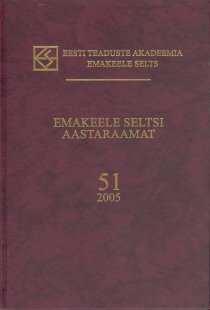Kolle-pere levikust ja semantilisest arengust
On distribution and semantic development in the kolle word group
Author(s): Enn ErnitsSubject(s): Language and Literature Studies
Published by: Teaduste Akadeemia Kirjastus
Keywords: lexis; semantics; etymology; dialect geography; Balto-Finnic languages
Summary/Abstract: The paper deals with words descended from the protoforms *kolta and *koltta with and without suffixes in the Estonian (kolle, kold 'hearth; opening in an oven for collecting ashes', koldas 'hollow bank; bank hollow', koltlik 'bumpy', etc.), Livonian (kūolta 'river-bank') and Finnish languages (kolle 'bend; fold', kollero 'cavity', etc.). First of all, the distribution of kolle and other words with different meanings ('hearth', 'hood', 'bulge-like elevation', 'border, brim', etc.) are discussed. From this discussion, it is assumed that *kolta and *koltta originated from the Finno-Ugric stem *kol- 'crevice, fissure, interspace' with the pseudosuffixes *-t- and *-tt-. The protoform *kolta initially denoted only the hearth, and its derivate *kolδõh (< *kolδõš) has acquired new meanings. The semantics of the kolle group are dominated by the concepts of the cavity and border. As a result of contamination of these meanings, the sense 'unevenness' has developed. Therefore, some words with the protoforms *kolta and *koltta designate not only excavations but also elevations (e.g. 'the thickest part of a rick'). It is possible that the derivates of *koltta designated natural excavations or hollow structures already from the beginning. Their connection with the oven in the East Estonian dialect may be secondary. The sense of ‘bank’ is also a result of contamination. The paper also deals with the distribution of the lexemes by languages, their dialects and subdialects. In the end of the study, data about the geography of the kolle group is generalized. Words without any suffix derived from *kolt(t)a are preserved in the peripheries of the Balto-Finnic language territory. The most disparate derivates of *kolt(t)a occur in the Kodavere and Maarja-Magdaleena subdialects of the East Estonian dialect; in the Kambja and Sangaste subdialects of the Tartuan dialect; in the Karksi subdialect of the Mulgi dialect; the Urvaste and Setu subdialects of the Võru dialect. They were probably the centres of prestige for distribution of the innovations.
Journal: Emakeele Seltsi aastaraamat
- Issue Year: 2006
- Issue No: 52
- Page Range: 033-050
- Page Count: 18
- Language: Estonian

